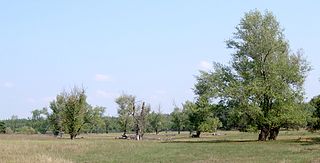
The substantia nigra (SN) is a basal ganglia structure located in the midbrain that plays an important role in reward and movement. Substantia nigra is Latin for "black substance", reflecting the fact that parts of the substantia nigra appear darker than neighboring areas due to high levels of neuromelanin in dopaminergic neurons. Parkinson's disease is characterized by the loss of dopaminergic neurons in the substantia nigra pars compacta.

Sambucus is a genus of flowering plants in the family Adoxaceae. The various species are commonly referred to as elder, elderflower or elderberry.

Pinus nigra, the Austrian pine or black pine, is a moderately variable species of pine, occurring across Southern Europe from the Iberian Peninsula to the eastern Mediterranean, on the Anatolian peninsula of Turkey, Corsica and Cyprus, as well as Crimea and in the high mountains of Northwest Africa.

Populus nigra, the black poplar, is a species of cottonwood poplar, the type species of section Aigeiros of the genus Populus, native to Europe, southwest and central Asia, and northwest Africa.

Linea nigra, denoted by its Latin translation "black line", colloquially known as the pregnancy line, manifests as a linear area of heightened pigmentation frequently observed on the abdominal region during pregnancy. Typically spanning approximately one centimeter in width, this brownish streak extends vertically along the midline of the abdomen, spanning from the pubis to the umbilicus. Variably, it may traverse from the pubis to the upper abdominal region.

Sambucus nigra is a species complex of flowering plants in the family Adoxaceae native to most of Europe. Common names include elder, elderberry, black elder, European elder, European elderberry, and European black elderberry. It grows in a variety of conditions including both wet and dry fertile soils, primarily in sunny locations. The plant is widely grown as an ornamental shrub or small tree. Both the flowers and the berries have a long tradition of culinary use, primarily for cordial and wine.

The Galápagos tortoise or Galápagos giant tortoise is a very large species of tortoise in the genus Chelonoidis. The species comprises 15 subspecies. It is the largest living species of tortoise, and can weigh up to 417 kg (919 lb). They are also the largest extant terrestrial cold-blooded animals (ectotherms).
The Wych Elm cultivar Ulmus glabra 'Nigra', commonly known as the Black Irish Elm, was found in the Kilkenny area c.1770 by the father of nurseryman John Robertson of Kilkenny, who later cultivated it. Robertson stated that he had not seen the form outside Ireland. It was listed by Loddiges (1830) as Ulmus nigra, and described by Loudon in Arboretum et Fruticetum Britannicum (1838), as Ulmus montana nigra. 'Nigra' is not mentioned in either Elwes and Henry's or Bean's classic works on British trees.

Nepenthes nigra is a tropical pitcher plant known from a number of mountains across Central Sulawesi, where it grows at elevations of 1,500–2,700 m (4,900–8,900 ft) above sea level. The specific epithet nigra refers to the dark colouration of the pitchers and stem. The species is closely related to N. hamata and N. tentaculata.

Hemilophini is a tribe of longhorn beetles of the subfamily Lamiinae.
Alampyris is a genus of longhorn beetles of the subfamily Lamiinae, containing the following species:
Alampyris curta is a species of beetle in the family Cerambycidae. It was described by Henry Walter Bates in 1881. It is known from Mexico.
Alampyris fuliginea is a species of beetle in the family Cerambycidae. It was described by Henry Walter Bates in 1881. It is known from Mexico.
Alampyris marginella is a species of beetle in the family Cerambycidae. It was described by Henry Walter Bates in 1881. It is known from Mexico.
Alampyris photinoides is a species of beetle in the family Cerambycidae. It was described by Henry Walter Bates in 1881. It is known from Guatemala.
Alampyris quadricollis is a species of beetle in the family Cerambycidae. It was described by Henry Walter Bates in 1881. It is known from Mexico.
Alampyris cretaria is a species of beetle in the family Cerambycidae. It was described by Henry Walter Bates in 1885. It is known from Mexico.
Alampyris flavicollis is a species of beetle in the family Cerambycidae. It was described by Galileo and Martins in 2005. It is known from Costa Rica.
Alampyris fusca is a species of beetle in the family Cerambycidae. It was described by Martins and Galileo in 2008. It is known from Costa Rica.
Alampyris melanophiloides is a species of beetle in the family Cerambycidae. It was described by Thomson in 1868. It is known from Mexico.








